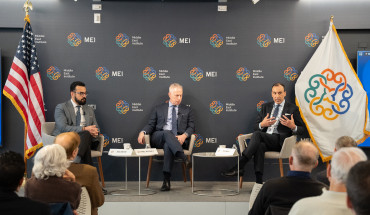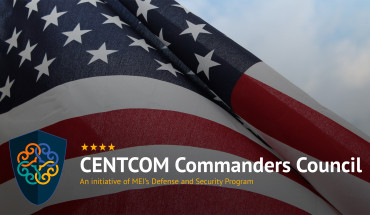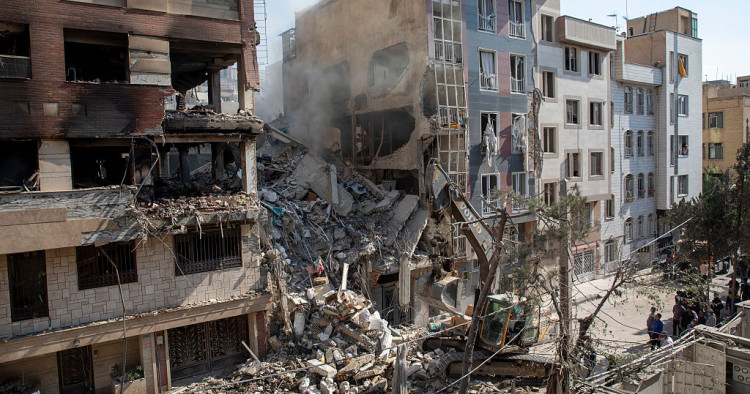Barely a week into Israel’s large-scale military campaign against Iran, the prospects for a diplomatic resolution are rapidly vanishing — if they have not already. What began as an effort to halt Iran’s nuclear program has morphed into a broader Israeli campaign aimed at degrading the regime’s security, economic, and political infrastructure in order to enable or encourage regime change.
This evolving confrontation places the Islamic Republic of Iran at a critical inflection point. Tehran faces choices that range from limited negotiation and strategic restraint to escalation and eventual collapse. The following analysis explores the key scenarios that could unfold in the coming days, weeks, and years.
I. A vanishing diplomatic off-ramp
Theoretically, a negotiated de-escalation is still possible. But the political and strategic costs for Tehran would be staggering. To satisfy President Donald Trump — and the new negotiator at the table, Israeli Prime Minister Benjamin Netanyahu — Tehran would likely have to offer: complete cessation of uranium enrichment down to zero; full dismantlement of enrichment infrastructure, including Fordow and Natanz, under stringent inspections led by the United States; and sharp reductions in its ballistic missile arsenal and manufacturing capacities, and maybe in its drone arsenal and factories as well. In addition, Israel would insist on the dismantling or disbanding of regional militias in Lebanon, Iraq, and Yemen.
For the Islamic Republic, such concessions would be tantamount to capitulation — or what Trump called “unconditional surrender.” Externally, that would leave the regime stripped of both deterrent capabilities and geopolitical leverage. Internally, it would also leave the regime exposed to backlash from hardliners and vulnerable to a disgruntled population already disillusioned by decades of authoritarian mismanagement and international isolation, making its weakness all too clear.
Moreover, it is unlikely the US administration would be inclined to throw a lifeline to a regime that appears to be collapsing under pressure. A last-minute deal would risk preserving a weakened regime just as the opportunity to topple it — or severely degrade its capacity — appears within reach.
In a few days or weeks, Iran is probably going to lose what remains of its nuclear enrichment capacities — i.e., Fordow. It also no longer has the option to “rush for a bomb,” a choice it might have had months or years ago, when it still controlled its airspace and security, and maybe at a time when Israel or the US were both distracted. Today, the run would likely be detected and destroyed before it gained any real momentum.
There may have been a brief window for diplomacy early in Trump’s second term, but Tehran misread the moment and Netanyahu narrowed the time window. That window now appears all but closed.
II. The escalation option: A high-risk gamble
If Tehran concludes that diplomacy is dead, one alternative is escalation. This would likely involve attacks on US bases in the region while it still has the capacity to do so; it might also include disrupting Gulf shipping and/or attacks on Gulf Cooperation Council (GCC) energy infrastructure or other targets. But this strategy is more useful in the threatening phase than in implementation. It would be a doomsday or suicidal decision for a regime that has not proven suicidal in the past but rather has always been intensely focused on its own survival. So this scenario remains unlikely. The Islamic Republic knows that such action would simply trigger large-scale US military engagement, likely with strong regional, European, and probably even Chinese support — as China cannot bear long-term high oil prices — and lead to an even more rapid destruction of the regime’s institutions and capacities.
III. Strategic endurance: Absorb, survive, adapt
The more likely option for Iran is to absorb the current military blows and shift to a strategy of weathering the storm. Iran may opt to accept the losses, preserve core regime structures, regroup over time, and pursue longer-term strategies. After all, regime change would require either a full-scale invasion, which is not in the cards, or a mass domestic uprising, which is unlikely in the immediate short term.
This trajectory echoes the cases of Saddam Hussein’s Iraq after the 1991 Gulf War and Bashar al-Assad’s Syria after 2012. The regime remains in power but severely weakened — unable to project major force, maintain full territorial control, or pose strategic threats beyond its borders.
In the Iranian context, this could involve loss of control over provinces with large minority populations like Kurdistan, Sistan-Baluchestan, or Khuzestan; armed uprisings in outlying regions, supported by external actors; and the eventual coalescence of these localized resistances with urban-based opposition movements in Tehran, Isfahan, and Shiraz.
Over a period of years, this could lead to regime collapse and some form of regime change. But it would unfold slowly, not as a sudden revolutionary shift. In the meantime, what is left of the regime would have time to assess, adapt, and try to reorganize.
IV. Asymmetric retaliation and a return to the shadows
Even in a degraded state, Iran retains some asymmetric capabilities. Its global and regional covert networks — built up over decades through the Islamic Revolutionary Guard Corps (IRGC) Quds Force, intelligence services, and proxy militias — may become its primary instruments of resistance.
This could include proxy attacks on Israeli, US, or allied interests; cyberattacks on infrastructure and financial systems; targeted assassinations or kidnappings abroad; and regional destabilization efforts in Lebanon, Syria, Yemen, Palestine, and Iraq.
This “submerged” posture mirrors the behavior of past embattled regimes. It will not restore Iran’s regional primacy, but it could impose persistent costs on its adversaries. For the United States and its partners in the region and internationally, this would represent a long-term destabilization, counterterrorism, and counterinsurgency challenge.
V. Regime mutation
While unpredictable, another possible scenario at some point is internal transformation — either through an intra-elite “coup” or a sharp managed transition.
A fracture within the IRGC or a realignment of the military and political elite could produce a new leader — or leadership — open to a transformative deal with the US and, indirectly, Israel. This would not be exactly like a “Gorbachev moment,” but something similar — a way to preserve the shell of a weakened Islamic Republic but recast in strategically new directions.
VI. Toward a muted endgame?
When Fordow is neutralized — and today it seems a matter of when and by whom, not if — and Iran’s nuclear and missile capacities are hollowed out, the pace of Israeli strikes may slow. At that point, a de facto cease-fire might be achieved — perhaps similar to the one arranged between Israel and Hezbollah last summer — that reduces the intensity of fighting and bombing (after key military sites have already been taken out). It would also precariously stabilize a new status quo in which Israel and the US retain the strategic upper hand, while Iran gets a respite from intense and open-ended bombardment. This scenario may offer all sides a tactical pause, even as long-term tensions persist.
From strategic power to contained threat
Israel has redrawn the regional map. The Islamic Republic, once a formidable and ambitious regional actor, is rapidly becoming a besieged and degraded power. It is likely to survive in the short term — but in what form, and with what purpose, remains unclear.
The pathways ahead range from slow-motion regime change to asymmetric entrenchment. What is already certain is that the Iran of late 2025 will look very different from the Iran of early 2023. The question is not only whether the Islamic Republic survives — but whether it evolves, collapses, or retreats into a long twilight of strategic irrelevance and subversive resistance.
Paul Salem is a Senior Fellow at the Middle East Institute (MEI). He previously served as MEI’s president and CEO and as vice president for international engagement. His research focuses on political change, democracy and governance, social and economic policy, as well as regional and international relations in the Middle East.
Photo by Majid Saeedi/Getty Images
The Middle East Institute (MEI) is an independent, non-partisan, non-for-profit, educational organization. It does not engage in advocacy and its scholars’ opinions are their own. MEI welcomes financial donations, but retains sole editorial control over its work and its publications reflect only the authors’ views. For a listing of MEI donors, please click here.













